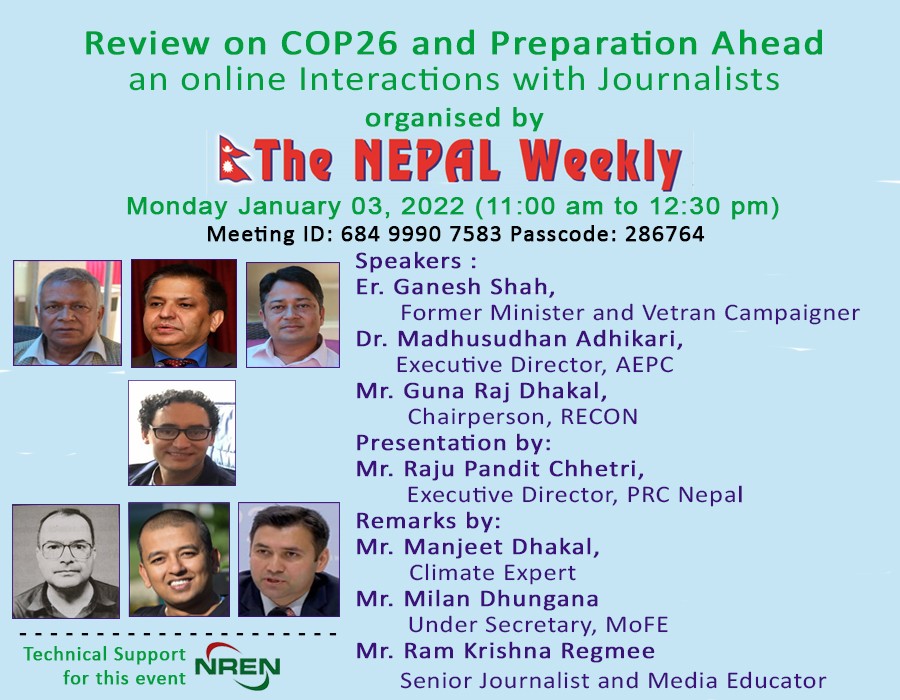 The Nepal Weekly
The Nepal Weekly  March 1, 2022
March 1, 2022
The book Journey to Tibet by Shree Bishnu Prasad Sharma Parajuli offers a different experience to its readers; perusal of a few initial pages in it prompts them to be a spontaneous partner of the trek. The writer, who has established himself as a high-altitude walker and a travel-author in Nepal over the past decade through his acts and works, utilizes journalistic skills in telling events, narration of feelings, description of places and explanation of values as their references emerge in the course of the trip.
Mr. Parajuli’s belief in sharing experiences appears to have been derived from the rich Nepali oral culture (Shruti-sanskriti) that his ancestors in Parbat district (Gandaki Province, Western Nepal) employed sincerely for ages in story-telling for transmitting knowledge, skills and also experiences of personal quests, explorations and feelings. The practice proved to be a reliable framework of sustaining communicating-cycle of learning among generations. His current book could be taken as a modern innovation –print and digital form- following the spirit of the same cycle. Had he not been encouraged by the spirit, he would have just enjoyed the journey, relaxed and stopped. But that is what the drive of sharing in him would not allow him to do; he instead moves to re-create the tour in text for the benefit of readers.
Shree Bishnujee, as revealed in the flow of expression, words and sentences of the book, does not simply toddle. He takes note of everything he steps in, goes in-depth for finding its meaning, detecting context, internalizing it, analyzing it and presenting it for others. It is just like the journalistic reporting he promotes. He actually became instrumental, over the past dozen years, in facilitating media persons, in all 77 districts including some remote areas of the country, to do press-work objectively and in the best interest of the public interest.
In this sense the book could be termed a meaningful reportage of his experience of the journey through which he seeks to energize the readers. It features real stories of walks, fatigues, rests, waits, nature-studies, interactions with people, their places, culture, food, history, sorrow over failure to develop and preserve natural and ancestral assets. It mirrors the panorama of the northern border of Nepal Himalayas including the highest mountain- Sagarmatha- from the Tibetan side besides presenting a rich narrative of what it is like trekking, travelling and getting immersed with life, transport, business and people in Tibet.
The writer dexterously walks readers to greatness of Simkot, Humla prior to presenting them with rare but real tale of Mansarovar, circumnavigation of Kailash (parikrama), tenth century Kingdom, and Lhasa. His search for legendary Nepali daughter Bhrikuti and the apostle of peace – Lord Buddha – in Tibetan capital and the growing city Shigatse is as fascinating as his feeling over bumping into the sight of the Rongbuk glacier and Tibetan-side of base-camp of Sagarmatha (Chomolungma), the highest point on earth.
The book Journey to Tibet has mainly three parts: the first covers small section of Nepal starting from Simikot to Hilsa of Humla, one of the remotest districts of Nepal along the Karnali ravine, the second and the third refer to the writer’s experience starting from Guge Kingdom, Earth Forest, Mt. Kailash, Lake Mansarovar, from West Tibet to Mt. Sagarmatha Base Camp, Rongbuk glacier and the mysterious Lhasa, the capital of Tibet (China) to the east.
Bishnu Prasad Sharma Parajuli, the author of the book Journey to Tibet, is also the writer of books in Nepali language: Dolpo: A Living Museum of the World, Shweta Parbat (White Mountain). A media trainer, researcher, trekker and writer born in Parbat District, Gandaki Province, West Nepal, Parajuli has made himself, through practical trekking experiences and penning books on Nepal, an enlightened authority and resource person on various dimensions of the Himalayas. He has completed most of the parts of the Great Himalayan Trail (GHT).
Mark Larsen, diplomat (retired), writes about the book: Journey to Tibet is something new, an arduous journey that highlights what is shared by the high mountain cultures of Nepal and Tibet, and what is changing on both sides of the world’s tallest mountains.
Stephen Franklin, senior journalist, describes Mr. Parajuli as a talented, wise, hearty, and joyful trekker. Most of all he is a Nepali with profound love for his nation and its culture, who treasures the gift of living in the embrace of a truly mystical beauty, a land of many mountains, the Himalayas.
According to Sian Pritchard-Jones and Bob Gibbons, the book Journey to Tibet is a gripping, masterful book describing the experiences of a Nepali adventurer as he shares the excitement, fascination and compulsion of following previous illustrious travelers to the forbidden lands. He has captured the very essence of Tibet. (Based on Foreword by R.K. Regmee, senior journalist, Nepal)

